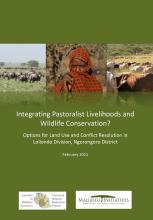/ library resources
Showing items 1 through 9 of 12.This report provides a synthesis of three country level case studies (Namibia, Senegal, Kenya) carried out in African countries as a part of the overall legal review of Indigenous People’s and Community Conserved Territories and Areas (ICCAs).
This report provides an overview of the conflict in Loliondo, reviewing historical information, current land uses and tenure arrangements.
One of the most wellknown biofuel investments was that of Bioshape, which acquired approximately 34,000 ha in Kilwa District for the cultivation of jatropha.
Like many of its neighbors, Tanzania is experiencing a well-documented surge of land grabbing related to investments in industries such as agriculture, biofuels, tourism, hunting, and forestry.
In the debate on climate change, it is frequently argued that the number of “climate refugees” is going to grow world-wide. So far, however, only little evidence has been provided of links between climate change, environmental changes and migration.
The tsunami disaster on 26 December 2004 claimed more than 200,000 lives.
2005 was a year of natural disasters.The impacts of the tsunami in the Indian Ocean, Hurricanes Katrina and Stan, and the Pakistan earthquake prompted calls for better disaster prevention and preparedness systems.
People-centred early warning systems empower communities to prepare for and confront the power of natural hazards.
The series of dramatic natural events is never ending. 2005 again illustrated that natural disasters are unavoidable. For disaster prevention systems to function properly, investments in raising risk awareness are key.
Pagination
Land Library Search
Through our robust search engine, you can search for any item of the over 73,000 highly curated resources in the Land Library.
If you would like to find an overview of what is possible, feel free to peruse the Search Guide.






